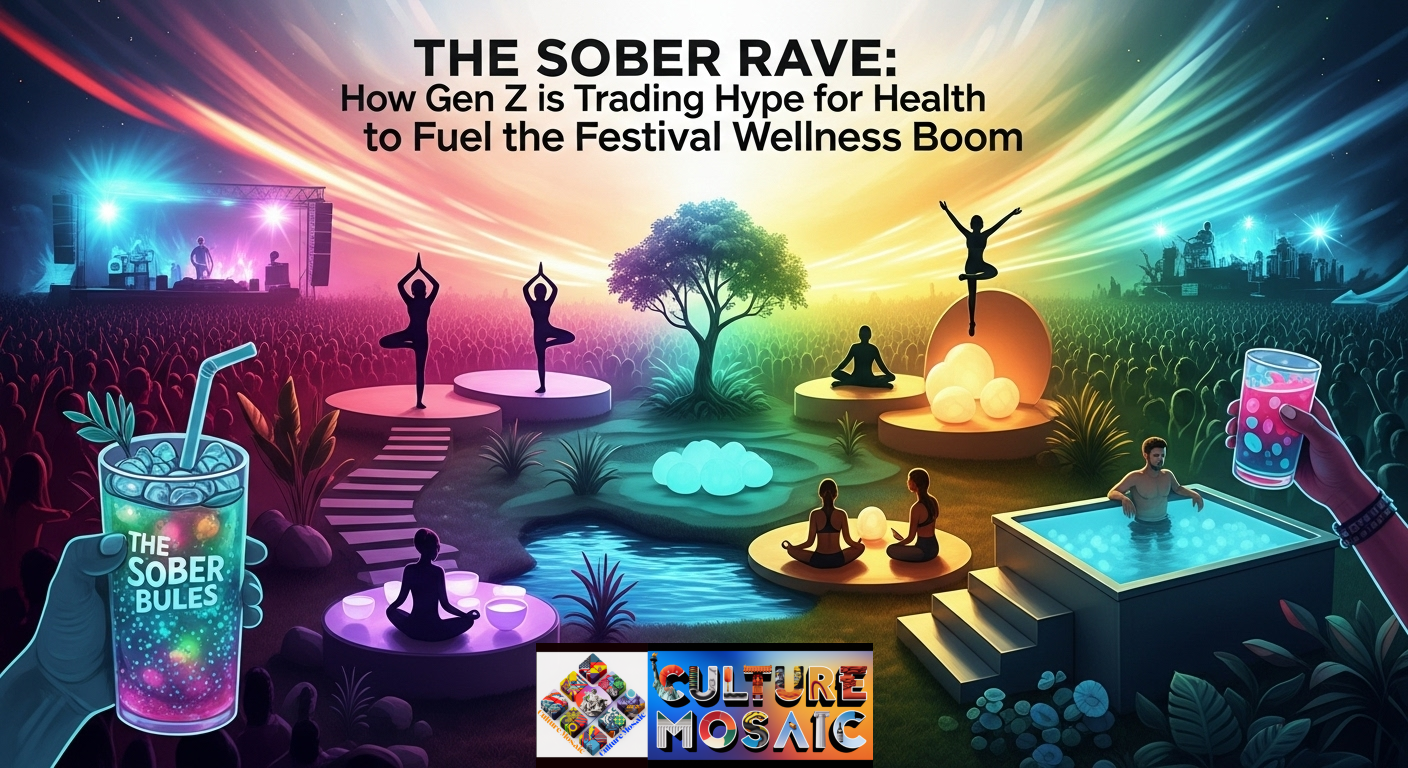Something interesting happened at Coachella last year. Between the main stage and the Ferris wheel, a tent offering ice baths and guided breathwork had a longer line than some of the headliners. Welcome to the era of festival wellness, where the afterparty might involve meditation instead of substance-fueled mayhem.
The American festival scene is experiencing a fundamental shift. What was once purely about losing yourself in the chaos is now equally about finding yourself in the calm. Gen Z attendees are showing up with kombucha instead of Coors, swapping hangovers for yoga flows, and turning what used to be a weekend of destruction into an experience of intentional self-care.
This isn’t just a passing trend. Festival wellness represents a $4.2 billion market shift that’s forcing event organizers to completely rethink their business models. The kids aren’t necessarily killing the vibe. They’re just redefining what the vibe means.
Understanding Festival Wellness in Today’s Event Landscape
Festival wellness encompasses the growing integration of health-focused activities, sober spaces, and recovery services at music festivals and large-scale events. It’s the recognition that attendees want to enjoy live music and community without compromising their physical or mental health.
The numbers tell the story. According to recent industry data, 34% of Gen Z festivalgoers now actively seek out events with dedicated wellness programming. That’s up from just 12% in 2019. These aren’t fringe attendees tucking into quiet corners. They’re reshaping the entire festival experience from the inside out.
Festival wellness manifests in multiple ways. You’ll find cold plunge stations next to food trucks. Meditation domes operate on the same schedule as DJ sets. Recovery lounges offer IV therapy and massage alongside the typical medical tent services. What used to be afterthoughts are now marketed features, sometimes even selling separate tickets.
The wellness zones aren’t empty either. Electric Forest, known for its transformative culture, reported that their healing sanctuary saw over 15,000 visits during their 2024 event. That’s roughly 40% of total attendance engaging with programming that has nothing to do with music.
The Rise of Sober Bars and Functional Beverage Culture
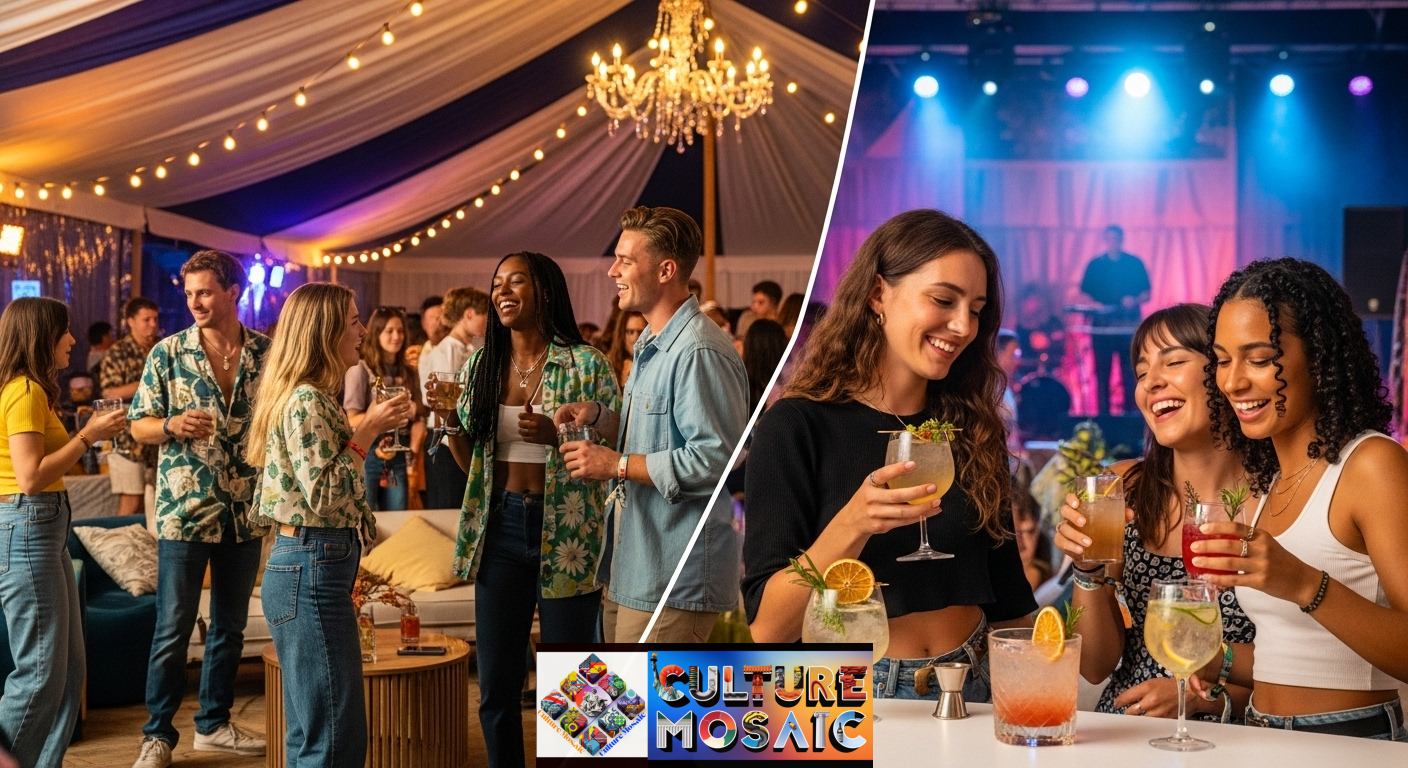
Walk into the VIP section of most major festivals now and you’ll find something unexpected: a bar serving zero-proof cocktails that cost as much as their alcoholic counterparts. These aren’t sad mocktails thrown together with juice and soda. We’re talking adaptogen-infused elixirs, nootropic blends, and CBD beverages crafted by mixologists who take the work as seriously as any craft cocktail program.
The sober bar phenomenon represents one of the most visible aspects of festival wellness. Brands like Kin Euphorics, Recess, and De Soi have become festival mainstays, offering functional beverages designed to enhance mood, increase social connection, or promote relaxation without alcohol. The drinks aren’t cheap, often running $12 to $18 per serving, but they’re selling out.
Lightning in a Bottle, a California festival known for its conscious community, introduced a dedicated sober space called “The Oasis” in 2023. The area featured its own stage, lounge seating, and a full menu of functional drinks. Organizers expected modest interest. Instead, they found the space operating at capacity throughout the weekend, with many attendees spending hours there between musical acts.
This shift isn’t happening in a vacuum. The broader sober curious movement has gained massive traction, particularly among people under 30. A 2024 study found that 61% of Gen Z adults are actively trying to reduce their alcohol consumption, compared to 38% of millennials at the same age. Festival organizers are simply responding to their audience.
The business case is compelling, too. Functional beverage sales at festivals carry higher margins than traditional alcohol, require fewer security concerns, and appeal to sponsors looking to align with wellness-focused consumers. Several major festivals have reported that their non-alcoholic beverage revenue has grown by over 200% in the past three years.
Wellness Programming as a Festival Headliner
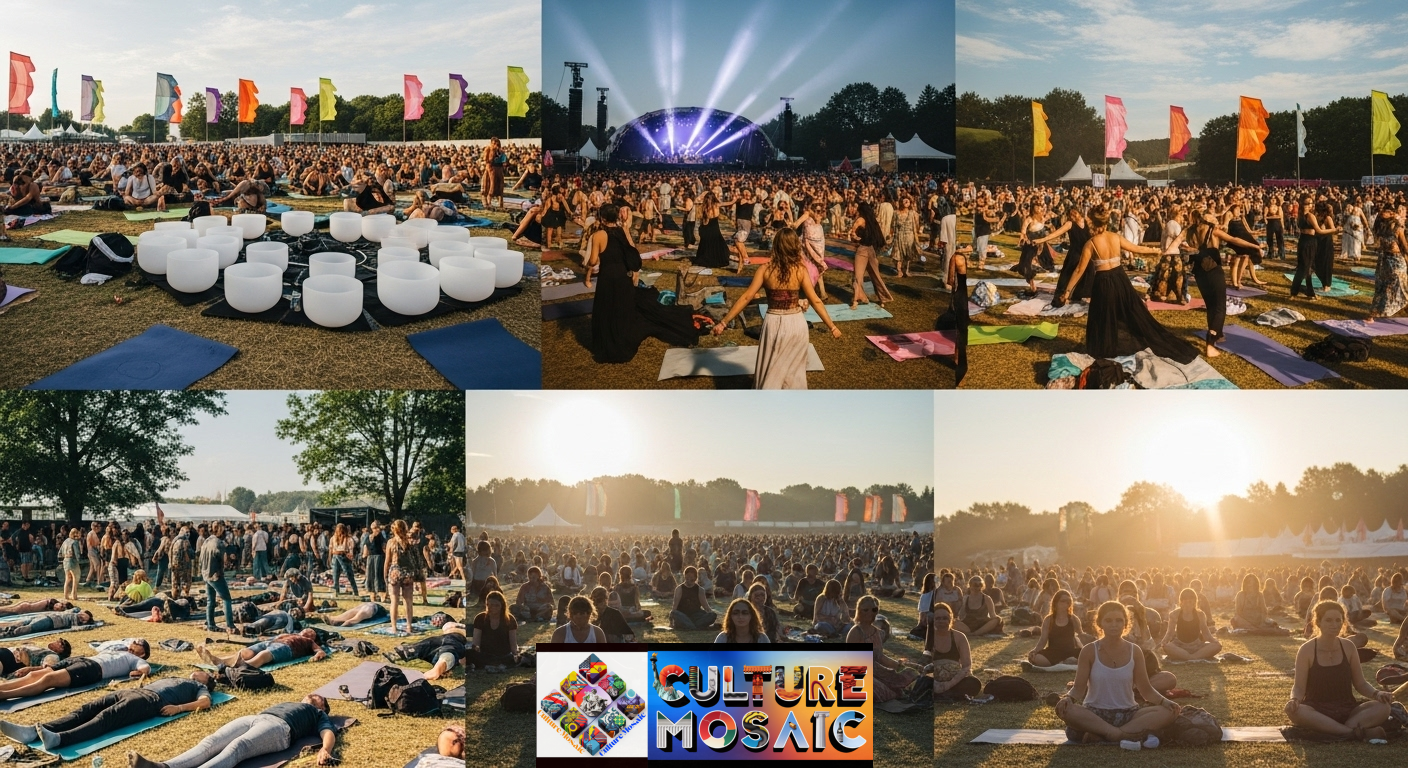
The schedule at Outside Lands 2024 included something remarkable: a sunrise sound bath that drew 3,000 people at 6:30 AM. That’s more than many afternoon music acts. Festival wellness has evolved beyond supplementary activities into programming that stands on its own as a draw.
Sound baths, breathwork sessions, ecstatic dance, and group meditation have become fixtures at major events. These aren’t casual drop-in offerings tucked away in forgotten corners. They’re scheduled experiences, often requiring advance sign-ups and sometimes charging premium prices for participation.
Bonnaroo launched their “Sanctuary” area in 2022, featuring yoga classes taught by recognized instructors, guided meditations, and workshops on topics like nervous system regulation and emotional processing. The programming ran from 8 AM to midnight, operating as essentially a separate mini-festival within the larger event. Attendance exceeded expectations by 400%, forcing organizers to expand the space significantly for 2023 and 2024.
The appeal makes sense when you understand what Gen Z wants from festival experiences. This generation reports higher levels of anxiety and stress than previous generations at the same age. They’re seeking tools and practices that help them manage mental health. If they can learn breathwork techniques while also seeing their favorite artists, that’s a win.
Festival wellness programming also creates a different kind of social space. Traditional festival environments can feel overwhelming, particularly for people managing sensory sensitivities or social anxiety. Wellness areas offer quieter alternatives where connection happens through shared practice rather than shouted conversation over loud music.
The instructors leading these sessions aren’t random yoga teachers either. Festivals are booking recognizable names from the wellness world, treating them with similar importance to musical acts. When your sound healing practitioner has 500,000 Instagram followers, they’re not just an amenity. They’re a selling point.
The Post-Festival Recovery Industry Boom

The festival ends Monday morning. By Monday afternoon, IV therapy clinics in nearby cities are fully booked with attendees seeking recovery services. The post-festival wellness industry has exploded into a legitimate business sector, capitalizing on festival wellness principles that extend beyond the event itself.
Recovery services now include IV hydration therapy, vitamin injections, massage therapy, cryotherapy, infrared sauna sessions, and specialized “festival recovery” packages combining multiple treatments. Companies like The IV Doc and Reset IV have built entire business models around serving festival markets, often setting up mobile clinics in hotels and parking lots near major events.
The pricing reflects the demand. A basic IV hydration treatment runs $150 to $250. Add glutathione for detox support, B vitamins for energy, or anti-nausea medication, and the cost easily exceeds $400. Yet these services sell out, with some providers reporting 70% repeat customers who book recovery appointments before even attending the festival.
Beyond immediate physical recovery, the post-festival period has spawned a social media content ecosystem. Search “festival recovery” on TikTok and you’ll find thousands of videos documenting elaborate self-care routines, supplement stacks, and wellness practices designed to minimize the crash after an intense weekend. The content isn’t ironic. These creators are genuinely sharing their approaches to sustainable festival attendance.
Some festivals have started incorporating recovery services on-site. Coachella offers IV therapy in its VIP areas. Lightning in a Bottle provides complimentary electrolyte stations and recovery smoothies. The messaging is clear: taking care of yourself isn’t something that happens after you leave. It’s part of the experience itself.
The post-festival recovery market also includes mental health support. Several organizations now offer “integration circles” and processing sessions designed to help attendees make sense of transformative experiences and manage the emotional comedown that often follows intense events. These sessions, often conducted via Zoom in the days following festivals, regularly attract hundreds of participants.
From Rage Culture to Ritual Culture: A Generational Shift
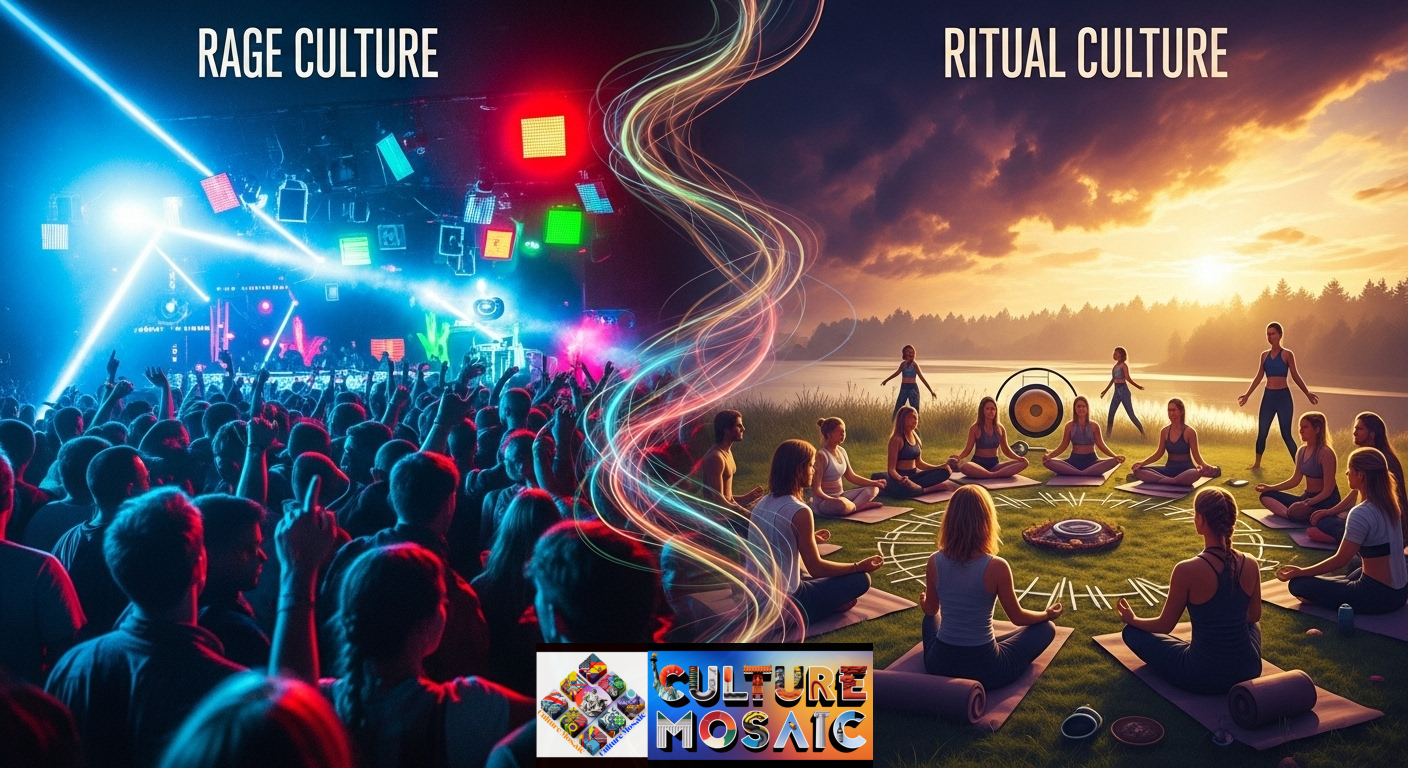
The old festival model was simple: show up, party as hard as possible, deal with the consequences later. Gen Z has a different approach. They’re treating festivals as rituals, intentional experiences designed for connection, self-expression, and even personal growth. This represents the core of what festival wellness truly means.
This shift reflects broader generational values. Gen Z prioritizes authenticity, mental health awareness, and sustainable practices. They grew up watching millennials struggle with burnout and substance issues. They’re choosing differently, seeking experiences that feel good during the moment and after.
The concept of “rage culture” celebrated excess. How little you slept, how much you consumed, how destroyed you felt afterward became badges of honor. Ritual culture flips that narrative. It celebrates presence, mindfulness, and the ability to fully remember and integrate your experiences. The goal isn’t oblivion. It’s a connection.
Festival wellness supports this ritual approach by providing tools and spaces that enhance awareness rather than diminish it. When you start your festival day with yoga and end it with a sound bath instead of an afterparty, you’re creating a different kind of experience. Not better or worse, just different. And increasingly popular.
This doesn’t mean the traditional festival experience has disappeared. Plenty of people still want to dance until dawn and embrace chaos. But the monoculture has fractured. Festivals now need to serve multiple audiences with different priorities, and wellness-focused attendees represent a growing and often more affluent demographic.
The business implications are significant. Wellness-oriented festivalgoers typically spend more money, cause fewer security issues, and create the kind of content that appeals to brand sponsors. They’re also more likely to attend multiple events per year, viewing festivals as part of a lifestyle rather than occasional blowouts.
Business Models Adapting to Festival Wellness Demands
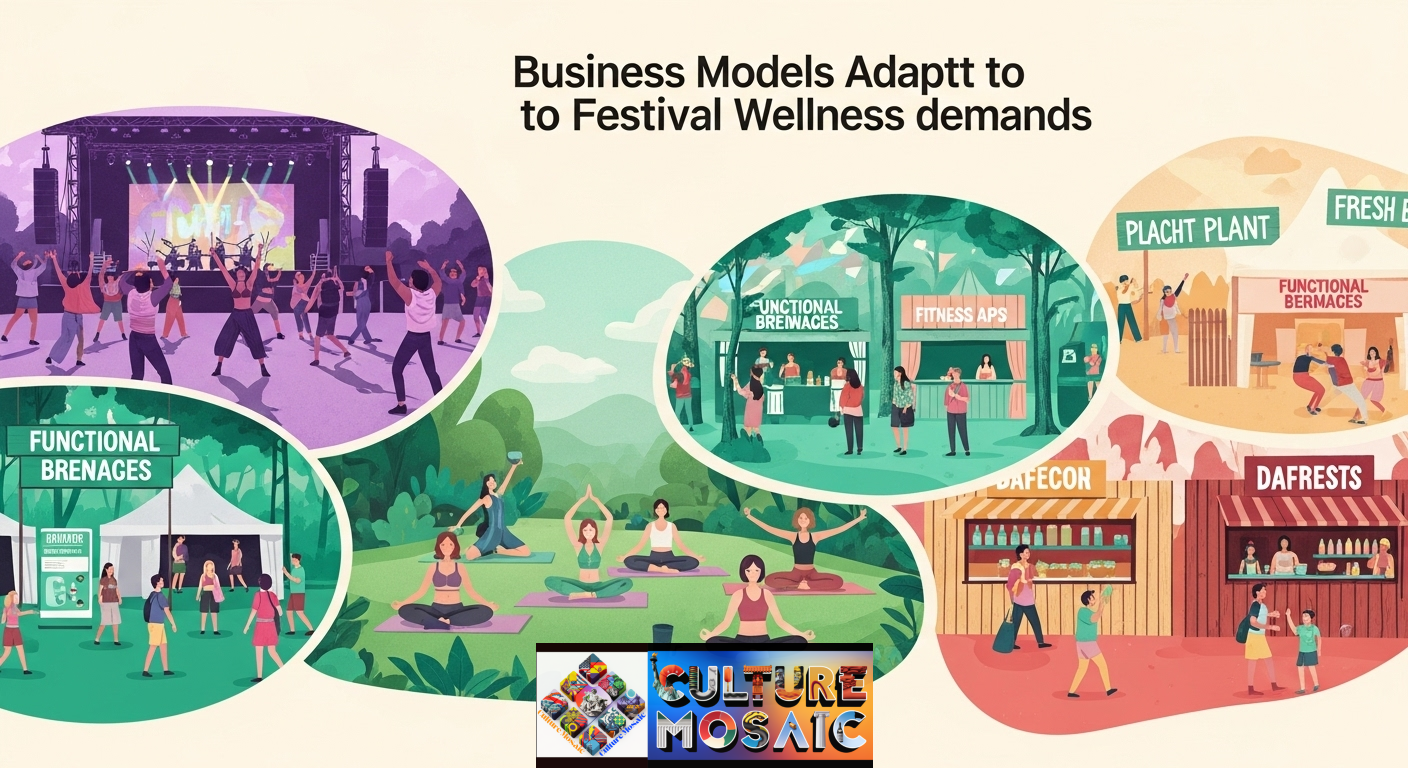
Festival organizers are restructuring their entire operations around wellness trends. This isn’t minor tweaking. We’re talking about fundamental changes to venue design, vendor selection, programming schedules, and revenue streams.
Desert Hearts, a boutique festival in Southern California, redesigned its layout in 2023 to create distinct zones for different energy levels. High-intensity dance areas exist alongside quiet spaces, wellness areas, and what they call “transition zones” where people can shift between different states. Attendee feedback indicated this zoning increased overall satisfaction by 40%.
Vendor selection now prioritizes health-focused options. Where festivals once filled food vendor spots with typical fried fare, many now require a minimum percentage of healthy, plant-based, or functional food options. The shift reflects attendee demand but also represents a branding opportunity. Festivals market themselves as wellness-conscious experiences, differentiating from competitors still operating on the old model.
Sponsorship deals have evolved, too. Traditional alcohol brands are being supplemented or replaced by functional beverage companies, supplement brands, fitness apps, and wellness technology companies. These sponsors often pay premium rates because they’re reaching their exact target demographic in an environment where those consumers are particularly receptive.
Some festivals have introduced tiered ticketing structures that separate wellness access. Want unlimited access to yoga classes, meditation sessions, and recovery lounges? That’s a wellness pass, often adding $200 to $500 to your ticket price. The remarkable part: these add-ons sell out early, sometimes before general admission tickets.
The festival wellness approach also affects insurance costs and liability concerns. Events that provide robust wellness services and sober spaces typically see reduced medical incidents, fewer security issues, and lower overall risk profiles. Some insurance providers now offer discounted rates for festivals, demonstrating a commitment to attendee wellness.
Festival Wellness and Mental Health: Breaking New Ground
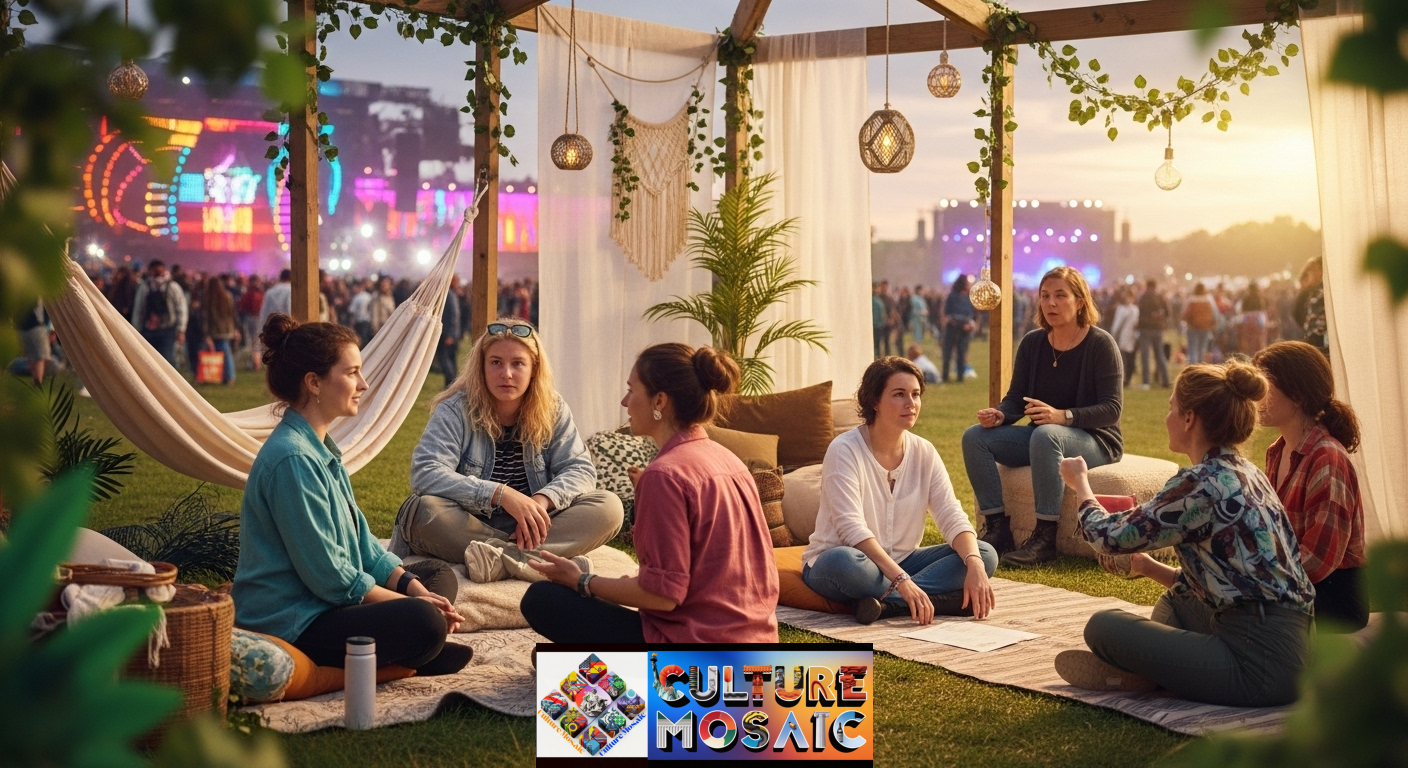
The mental health component of festival wellness deserves particular attention. Festivals have always been spaces where people experiencing mental health crises could end up needing support. Now, instead of just reactive medical response, events are building a proactive mental health infrastructure.
Several major festivals now employ licensed therapists and peer support specialists specifically trained in psychedelic harm reduction and crisis intervention. These professionals staff dedicated wellness areas where attendees can process difficult experiences, manage anxiety, or simply talk through whatever they’re feeling.
The Zendo Project, a harm reduction organization, has provided psychedelic peer support at festivals since 2012. Their model has influenced countless festivals to create similar spaces. In 2024, they reported supporting over 2,000 people across various events, with 89% of those interactions involving no substances whatsoever. People were seeking support for anxiety, overwhelm, grief, or just needed a quiet space to regulate.
This mental health focus extends to programming designed to teach practical skills. Workshops on managing festival anxiety, navigating social situations while sober, and processing intense emotional experiences are now common. These sessions often fill, indicating significant unmet demand for this kind of support.
The integration of mental health support into festival wellness makes these events more accessible to people who might otherwise avoid them. Knowing that professional support exists if things become overwhelming lowers the barrier to attendance for people managing anxiety, depression, or other mental health conditions.
The Role of Technology in Festival Wellness
Festival wellness has a surprisingly robust technology component. Apps, wearables, and digital platforms are being integrated into the wellness experience in ways that enhance rather than distract from the present moment.
Several festivals now offer dedicated wellness apps that allow attendees to schedule yoga classes, book massage appointments, and receive reminders for meditation sessions. These apps often include features like guided breathwork exercises, festival-specific meditation content, and tools for finding your friends in wellness areas.
Wearable technology has found an interesting niche at festivals. Some events partner with companies providing biometric tracking that monitors heart rate variability, sleep quality, and stress levels throughout the festival. Attendees receive personalized recommendations for recovery activities based on their data. The privacy concerns are real, but adoption among wellness-focused festivalgoers has been strong.
Virtual reality meditation experiences have started appearing at major festivals. These installations offer immersive guided meditations designed for the festival environment, providing deep relaxation in short timeframes. Lightning in a Bottle’s VR meditation dome saw over 5,000 visitors in 2024, with average session lengths of 20 minutes.
The technology integration serves the festival wellness mission by making wellness activities more accessible and easier to incorporate into packed festival schedules. When you can book a sound bath from your phone and receive a reminder 15 minutes before it starts, you’re more likely to actually attend.
Sustainability and Festival Wellness: Natural Partners
The intersection between festival wellness and environmental sustainability creates a powerful synergy. The same values driving wellness consciousness often align with environmental awareness, and festivals are leveraging this connection.
Wellness areas frequently emphasize sustainable design, using reclaimed materials, operating on solar power, and implementing zero-waste practices. These choices aren’t just environmental. They’re part of the wellness narrative, creating spaces that feel aligned with natural systems rather than fighting against them.
Several festivals have introduced wellness-focused sustainability initiatives. Symbiosis Gathering, known for its environmental commitment, created a program where attendees could earn wellness services like massage or yoga classes by volunteering for environmental cleanup efforts. The program successfully engaged over 40% of attendees in active sustainability participation.
The plant-based food movement dovetails perfectly with festival wellness. Many wellness-oriented festivalgoers are reducing or eliminating animal products, creating demand for high-quality vegan options. Festivals responding to this demand often find that their sustainable food vendors become major attractions, with lines comparable to popular musical acts.
This sustainability-wellness connection also affects transportation and accommodation options. Festivals are partnering with companies offering eco-friendly transportation, creating bike-powered stages and wellness areas, and encouraging camping over hotel stays as a way to connect with nature as part of the wellness experience.
The Economic Impact of Festival Wellness
The festival wellness movement represents serious money. Beyond ticket sales and sponsorships, this shift is creating entirely new economic ecosystems around events.
Wellness-focused festivals can command premium pricing. When Lightning in a Bottle sells out at $450 for general admission, compared to similar-sized festivals at $300, much of that price difference reflects their wellness programming and infrastructure. Attendees are willing to pay more for the experience they want.
The vendor ecosystem has expanded significantly. A major festival might now include 15 to 20 wellness-focused vendors, from massage therapists and acupuncturists to functional beverage companies and supplement sellers. These vendors often report festival sales accounting for 20% to 40% of their annual revenue.
Local economies benefit too. When festivals attract wellness-conscious attendees, those visitors often extend their stays to explore local yoga studios, healthy restaurants, and natural attractions. Desert Hearts’ economic impact study found that their attendees spent an average of $800 in the local community beyond festival-related expenses, significantly higher than the $450 average for traditional festival attendees in similar locations.
The post-festival economy extends across multiple sectors. Hotels and Airbnbs near major festivals now market “recovery packages” including late checkout, healthy breakfast options, and access to wellness facilities. These packages command premium rates and maintain high occupancy.
Challenges and Criticisms of Festival Wellness
Festival wellness isn’t without its critics and challenges. The movement faces legitimate questions about accessibility, authenticity, and potential cultural appropriation that deserve examination.
Cost presents the most significant barrier. When wellness programming requires premium tickets, and functional beverages cost $15 each, these experiences become accessible primarily to affluent attendees. This creates a two-tiered festival system where wellness becomes a luxury good rather than a universal option.
Some critics argue that festival wellness represents the commercialization and commodification of practices that originated in marginalized communities. Sound healing, breathwork, and plant medicine traditions come from specific cultural contexts, and their transformation into festival amenities raises ethical questions about appropriate cultural exchange versus appropriation.
The authenticity question comes up frequently. Are festivals genuinely committed to wellness, or are they just capitalizing on trendy marketing? When a festival adds a yoga tent but continues partnering with alcohol brands as primary sponsors, the commitment can feel superficial.
There’s also the question of whether festival wellness is sustainable long-term or represents a passing trend. Skeptics point out that previous wellness movements have come and gone, and festival culture has always been somewhat cyclical in its interests and priorities.
The medical community has raised concerns about some festival wellness offerings, particularly around IV therapy, supplement sales, and services that make health claims without proper medical oversight. The regulatory gray areas around these offerings create potential risks for attendees.
The Future of Festival Wellness
The trajectory of festival wellness suggests this isn’t a temporary trend but rather a fundamental restructuring of how people approach festival experiences. Several emerging developments point toward where this movement is heading.
Specialized wellness festivals are proliferating. Events like Wanderlust and Bhakti Fest focus almost exclusively on wellness programming, treating music as a supplement rather than the main attraction. These festivals are growing in attendance and number, suggesting strong market demand for wellness-first experiences.
Integration of psychedelic therapy and harm reduction is likely to expand significantly as legal and medical frameworks evolve. Several festivals are already working with researchers studying the therapeutic potential of festival experiences, and this research could inform future programming.
The technology component will likely deepen. Expect to see more AI-powered wellness recommendations, advanced biometric tracking, and possibly even brain-computer interfaces designed to enhance meditative states or optimize recovery.
Corporate festivals represent an interesting emerging sector. Companies are creating internal festivals for employees that emphasize wellness, team building, and skill development alongside entertainment. This corporate adoption could significantly expand the festival wellness market and influence mainstream festival culture.
The international spread of American festival wellness culture is already happening. European and Asian festivals are adopting wellness programming, though often adapting it to local cultural contexts and preferences. This global exchange could produce interesting hybrid models.
Practical Guide: Maximizing Your Festival Wellness Experience
For attendees interested in embracing festival wellness, some practical strategies can significantly improve your experience.
Pre-festival preparation matters more than most people realize. Start a sleep schedule that matches festival timing at least a week before. Increase your hydration baseline. If you’re planning to participate in yoga or dance activities, begin a light practice beforehand to prepare your body.
Create a festival wellness schedule. Don’t wing it. When you receive the schedule, mark the wellness activities you want to attend just like musical acts. Treat that 10 AM yoga class with the same commitment you’d give a headliner.
Pack a wellness kit: electrolyte packets, magnesium supplements, earplugs, a sleep mask, a journal, and any medications you need. Many seasoned festival wellness practitioners also bring foam rollers, essential oils, and extra layers for temperature changes in meditation spaces.
Set boundaries and communicate them. If you’re attending with friends who have different priorities, establish clear expectations. You don’t need to do everything together, and having permission to split up for wellness activities reduces pressure.
Use transition rituals between high-energy and rest periods. Even five minutes of intentional breathing between a dance set and heading to your tent can significantly impact your recovery and overall experience.
Stay flexible. Festival wellness isn’t about rigid rules or perfect execution. If you skip the morning yoga for extra sleep, that’s okay. The goal is sustainable enjoyment, not wellness perfectionism.
Festival Wellness and Community Building
One of the most significant but underreported aspects of festival wellness is its role in creating new forms of community. These wellness spaces become gathering points for people seeking similar experiences, often leading to connections that extend beyond the festival itself.
The community forming around festival wellness looks different from traditional festival friendships. Connections often happen through shared practice: you see the same faces at morning yoga, recognize people from the meditation dome, and bond with strangers during breathwork. These interactions tend to be more intentional and sometimes more meaningful than connections made in chaotic party environments.
Many festivals have created dedicated Facebook groups, Discord servers, or other online communities for wellness-focused attendees. These digital spaces allow people to coordinate meet-ups, share resources, and maintain connections between events. Some of these communities have grown to thousands of members, organizing their own gatherings and creating sustained networks.
The sober and sober-curious community at festivals deserves particular mention. For people in recovery or choosing sobriety, festivals can be challenging environments. The growing presence of sober spaces and communities within festivals provides crucial support and belonging. Several festivals now host recovery meetings, something that would have seemed absurd a decade ago.
This community aspect extends to skill sharing and mutual support. Experienced practitioners often informally teach techniques to newcomers in wellness spaces. The atmosphere tends to be less hierarchical and more collaborative than traditional festival environments, creating opportunities for genuine exchange.
FAQ Section
What is festival wellness, and why is it becoming so popular?
Festival wellness refers to the integration of health-focused activities, sober spaces, and self-care practices into music festivals and large events. It’s gaining popularity because Gen Z and younger millennials are prioritizing mental health and sustainable enjoyment over the traditional party-hard festival culture. The movement reflects broader societal shifts toward wellness, mindfulness, and the sober curious lifestyle.
Are festival wellness activities only for sober people?
Not at all. Festival wellness activities are designed for anyone interested in enhancing their experience through self-care practices. Many attendees participate in morning yoga or afternoon sound baths while still enjoying traditional festival activities. The wellness programming provides options and balance rather than requiring any specific lifestyle commitment.
How much does it cost to access wellness programming at festivals?
It varies significantly by festival and activity. Some events include all wellness programming in general admission tickets, while others charge premium wellness passes ranging from $200 to $500. Individual activities like massage or specialized workshops might cost $50 to $150 per session. Functional beverages at sober bars typically run $12 to $18. Always check specific festival offerings when budgeting.
Can festival wellness really help with anxiety and mental health during events?
Yes, research and anecdotal evidence suggest that wellness practices can significantly help manage festival-related anxiety and overwhelm. Having access to quiet spaces, breathing techniques, and mental health support allows people to regulate their nervous systems throughout the event. Many festivals now employ trained professionals specifically to support attendees’ mental health, and participation in wellness activities has been associated with reduced medical incidents.
What should I bring to make the most of festival wellness opportunities?
Pack a dedicated wellness kit including: electrolyte supplements, magnesium for muscle recovery, comfortable clothes for yoga or movement classes, a journal for processing experiences, earplugs, and a sleep mask for rest, a water bottle with extra capacity, and any personal medications. Many festival wellness veterans also recommend bringing a small foam roller, a light blanket for meditation sessions, and layers for temperature changes in wellness spaces.
The festival wellness movement represents more than just a trend. It’s a fundamental reimagining of what festivals can be and who they can serve. As this shift continues, we’re likely to see even more innovation in how events balance excitement with sustainability, community with commerce, and transcendence with health.
The kids trading substances for sound baths aren’t killing the party. They’re evolving it into something that might actually last.

